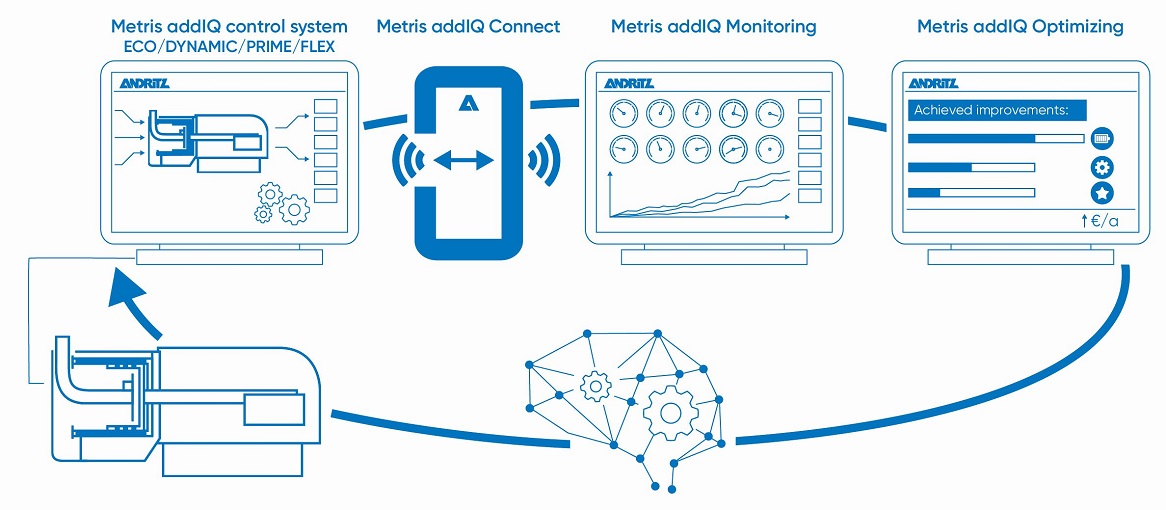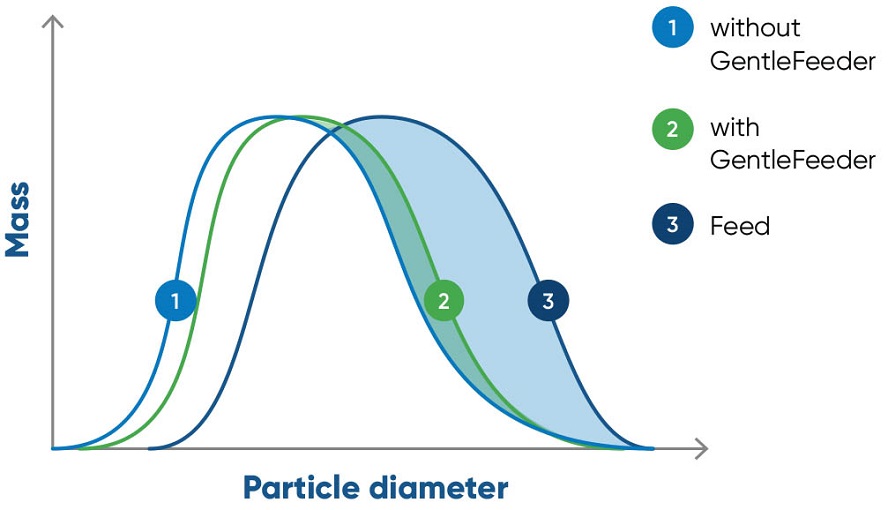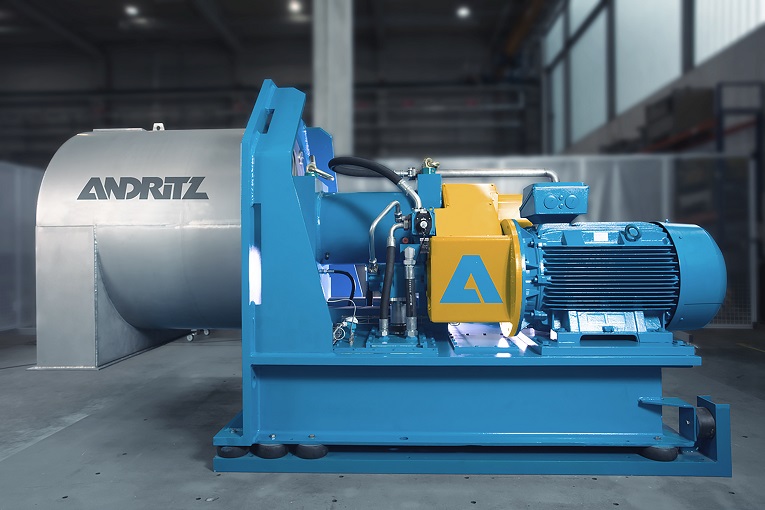


A pusher centrifuge is a continuously operating filtration centrifuge used for processing bulk products in the chemical or mineral industries. This article looks at pusher centrifuge technology over the last decade and how it has redefined product quality, energy efficiency and operations.
Normally, pusher centrifuges operate best at solids concentrations of >40% and an average particle diameter of (dp50) >100 µm. These certainly were the limits before international technology group Andritz began to push boundaries within the industry
The operation of a pusher centrifuge is simple. The suspension is fed through a feed pipe (or a feed screw if the products are not free flowing) into the feed distributor that rotates with the basket, which accelerates the suspension and feeds it evenly distributed into the feed zone.
Most of the liquid is filtered off here. In the feed zone, the solids grow to form a stable filter cake ring, which is conveyed in the direction of the solids’ discharge. At the end of the basket, the solids are ejected with every pusher movement, creating a continuous solids discharge.
Pusher centrifuges come in all shapes and sizes. The smallest centrifuges have a minimum throughput of at least 100 kg solids per hour, whereas the biggest model Andritz offers, the SZ 1250, processes up to 150 t/h. What unites them all is that the feeding, filtration, and operation of these units have become easier, more reliable and economical over the past few years.
Particle breakage One feature that increases reliability is the Andritz GentleFeeder feeding system. In all pusher centrifuges, the suspension is accelerated to a rotational speed of more than 100 km/h over a distance of just a few decimeters and in fractions of a second. If this acceleration is not performed in the most appropriate way, the feeding process is prone to suffering problems with particle breakage and non-ideal distribution. Distributing the suspension evenly is also crucial to smooth operation of a pusher centrifuge as it minimises the risk of imbalance, a main cause of increased wear on the machine and screen.
Minimised particle breakage is also desirable, as the negative impact of a high proportion of fines in the discharged product can lead to higher residual moisture content in the cake and less throughput because the more the particles break, the more material and thus valuable end product will be lost in the filtrate.
The Andritz GentleFeeder feeding system solves both problems. The suspension is received and drawn in gently by specially shaped, rotating vane-type distributors with a small inner diameter and accelerated evenly and carefully. Then the suspension is pre-accelerated until there is very little difference between the rotational speed of the suspension and that of the centrifuge basket, resulting in reduced particle breakage as well as smoother and quieter machine operation with reduced wear.
Pre-filtration technology To ensure smooth operation of a pusher centrifuge, most of the liquid must be removed by centrifugal force in the feed zone. At low solids’ concentrations, liquid that is not removed fast enough by filtration can splash around due to the pusher movement and then re-wets the already dry filter cake. In order to prevent these problems, external thickening systems such as hydrocyclones or bent screens are used in many cases. Andritz has resolved this issue in a different way.
Its patented pre-filtration technology tackles the root cause of the problem. An additional feed stage is included, doubling the liquid capacity of the centrifuge at constant solids’ throughput and product quality. As a result, suspensions with a low solids’ content of as little as 10% can also be processed without external pre-thickeners and pusher centrifuges with pre-filtration technology can deal with temporary or permanent upstream changes without requiring any further intervention by the operator.
The ecoOne series Pusher centrifuges generally contain between one and three basket stages. Single-stage machines can be used very successfully for coarse grains and products with low friction coefficients that are easy to dewater, three-stage machines are especially suitable for fine-grain products with high friction coefficients, and two-stage machines are a good compromise and are used most often in practice.
Rebuilding a machine to include a different number of stages usually requires a complete change of baskets, but the exceptions to this are pusher centrifuges from the ecoOne series. Due to the modular structure of the baskets, the rebuild can be completed in a normal 8-hour shift without the need to purchase a new set of baskets. This enhances flexibility of production by adding the opportunity to process different products using the same centrifuge or adapt it to changing production conditions during its life cycle (30+ years).
Along with the ecoOne machine comes the ecoOne motor, which is a combined drive and pusher motor that reduces power consumption by 10–20% and installed power by 20–40%. Pusher centrifuges with two motors generally only require the full power of the drive motor during the start-up process, and this motor then only operates at partial load during steady state operation.
Conversely, the pusher motor runs at virtually no load during machine start-up because there are no solids in the machine yet to be pushed. Hence, the pusher does not operate under load until stationary operation begins. Centrifuges operating with the ecoOne technology make use of these circumstances: The reserve capacity available for pushing is used during the start-up process to accelerate the basket, whereas the reserve capacity available for the start-up process is used for pushing during stationary operation. Additional benefits, such as a 40% reduction in oil consumption, are the icing on the cake.
Minimising maintenance Pusher centrifuges are frequently used with highly corrosive and abrasive products, which cause severe wear. Suitable materials like high-grade stainless steels, duplex or super-duplex steel grades for high temperatures or particularly aggressive conditions or, in some cases even titanium, reduce wear significantly. Additionally, regular inspections and maintenance work are essential to ensure efficient and reliable operation. In this environment, the Andritz pusher centrifuges rely on cartridge technology. The entire rotating unit is pulled out of the centrifuge in one piece without having to detach the machine pipework, the replacement cartridge from stock can be installed during maintenance work. The result is a break in production operations of less than one shift.
The most recent innovation, the Metris addIQ control system which is also available as an upgrade for existing machines, makes the pusher centrifuge ready for the future. The nucleus of this solution is a modular, PLC-based control system that helps the operator to make best use of the filter centrifuge. It maximises machine performance through the Metris addIQ Optimizing, enables remote support with Metris addIQ Connect, and allows the operator to monitor the machine 24/7 from anywhere in the world with the Metris addIQ Monitoring or enables preventive maintenance.
In addition, the pusher stroke monitoring function observes the frequency of the pusher stroke, ensuring easy detection of any blockages, hence providing an optimised process. The Metris addIQ control system paves the way for all future IIoT and industry 4.0 solutions tailored for pusher centrifuges.





